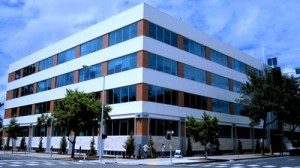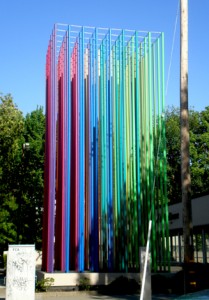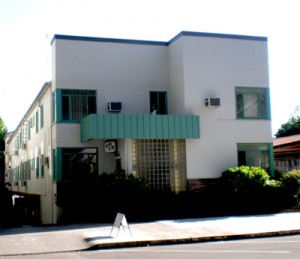Midtown Moderne
Posted on June 3, 2010 – 7:45 AM | by OldManFosterBy William Burg
In the two decades after World War II, most of Sacramento’s growth was directed outward into the new suburbs, and much of downtown was demolished by urban renewal and highway construction. Midtown’s bungalows and foursquares were mostly left intact, but considered obsolete housing as the middle class fled the central city. New construction followed the Modernist fashions of the day, including then-new materials like concrete, glass and steel, and new styles inspired by Bauhaus, Prairie and International Style schools of architecture. Often they displaced older landmarks that had fallen into disuse, like the Modernist 1952 Sacramento Bee office building that replaced the monumental Victorian-era Buffalo Brewery at 21st and Q Street. Today, Midtown is best known for its Victorian and early 20th century architecture, but examples of mid-century architecture and design can be found alongside century-old Queen Annes and heritage trees.
During the mid-century era, Midtown’s colorful Italianates were considered gaudy firetraps, Craftsman bungalows plain and uninviting, and revival styles simply unfashionable. Minimalist but bold, Modernism was far better suited to the exciting space-age era of high-speed freeways, jet airplanes, and nuclear power. Today, the architecture of the 1950s and 1960s seems just as unloved and unlovable, another architectural fad past its prime. Considered out of place among ‘classic’ architecture, many will certainly fall to development and infill. Those that survive will probably be the examples whose design best reflected an era when Sacramento designers and architects reached for the stars, inspired by the soaring altitudes of jet aircraft at Mather or McClellan Air Force bases, or rockets designed at Aerojet.
Following are a few examples from the heart of Midtown:
New office buildings grew from the Downtown core into Midtown, replacing older homes and businesses along streets converted to one-way boulevards. They provided amenities like parking and air conditioning that older downtown offices lacked. In 1953, the California Western Life Insurance Company relocated from their old building at 926 J Street (today the home of the Citizen Hotel) for this mid-rise office at 21st and L Street. Today, the building is in mid-facelift, but its clean Modernist lines are still apparent.
Commercial buildings used new materials and technology to attract passing motorists to stop at their storefronts. The Sleeper’s building used the popular Modernist convention of Mondrian-inspired irregular rectangles to create an immense glass wall, held in place by aluminum frames, for their new J Street storefront. The passing motorist could pull into Sleepers’ convenient adjacent parking lot. Many older central city commercial buildings used metal and enamel “slipcovers”, stucco façade remodels, and enlarged display windows to disguise their 19th century origins, but Sleeper’s was designed as a high-technology building to supply Sacramento’s high-technology businesses with Selectric typewriter ribbon and carbon paper.
.
.
.
This assemblage of 81 metal poles is well-known to Midtown residents, commuters, and consumers of recreational substances, for their eye-catching colors and shifting geometric patterns. The poles were designed for Fuller-O’Brien Paints by the studios of famed graphic designer Saul Bass. Bass was not personally responsible for the design; that project fell to one of his employees, designer Richard Hastings. Later leaving the graphic design trade to pursue his interest in historic buildings, Hastings moved to Sacramento and became the city’s first preservation director. Today, the Fuller-O’Brien paint store is a blood bank, but Hastings’ eye-catching poles have become a neighborhood icon in their own right.
.
.
.
.
.
During the postwar boom, there was great demand for inexpensive apartments in the central city. Midtown had a few old apartment buildings, and larger single-family homes converted into janky apartments and rooming houses, but supply still fell short of demand. Investors purchased Midtown homes, demolished the existing buildings, and built long, narrow, cheaply constructed 2-3 story apartment buildings to fill most of the lot. Parking was located in the alley or underneath the building. While scorned by preservationists for their displacement of earlier architecture, they provide abundant and relatively affordable housing in the central city. Some even consider Midtown’s many apartments, nearly 90% of the housing stock, to make Sacramento’s central city almost ungentrifiable.
The name “dingbat” comes from the use of starbursts or other decorative elements on the building front, providing an accent for buildings that are otherwise little more than stucco boxes. Some feature token elements of International Style architecture, a more Modernist idiom or even Googie elements, while others just resemble a cardboard box with aluminum windows. Later examples often featured a shingled Mansard roof for a laid-back northern California look. This example features glass-block windows and a mixture of vertical and horizontal design elements.







6 Responses to “Midtown Moderne”
By Joe Gamble on Jun 4, 2010 | Reply
Excellent article Mr. Burg!
By wburg on Jun 5, 2010 | Reply
There were so many good ones I had to leave out for space and time considerations–the SMUD substation at 19th and N, for starters, some other intriguing office buildings, the concrete Brutalist public/senior housing towers…guess I’ll have to do a follow-up article next year!